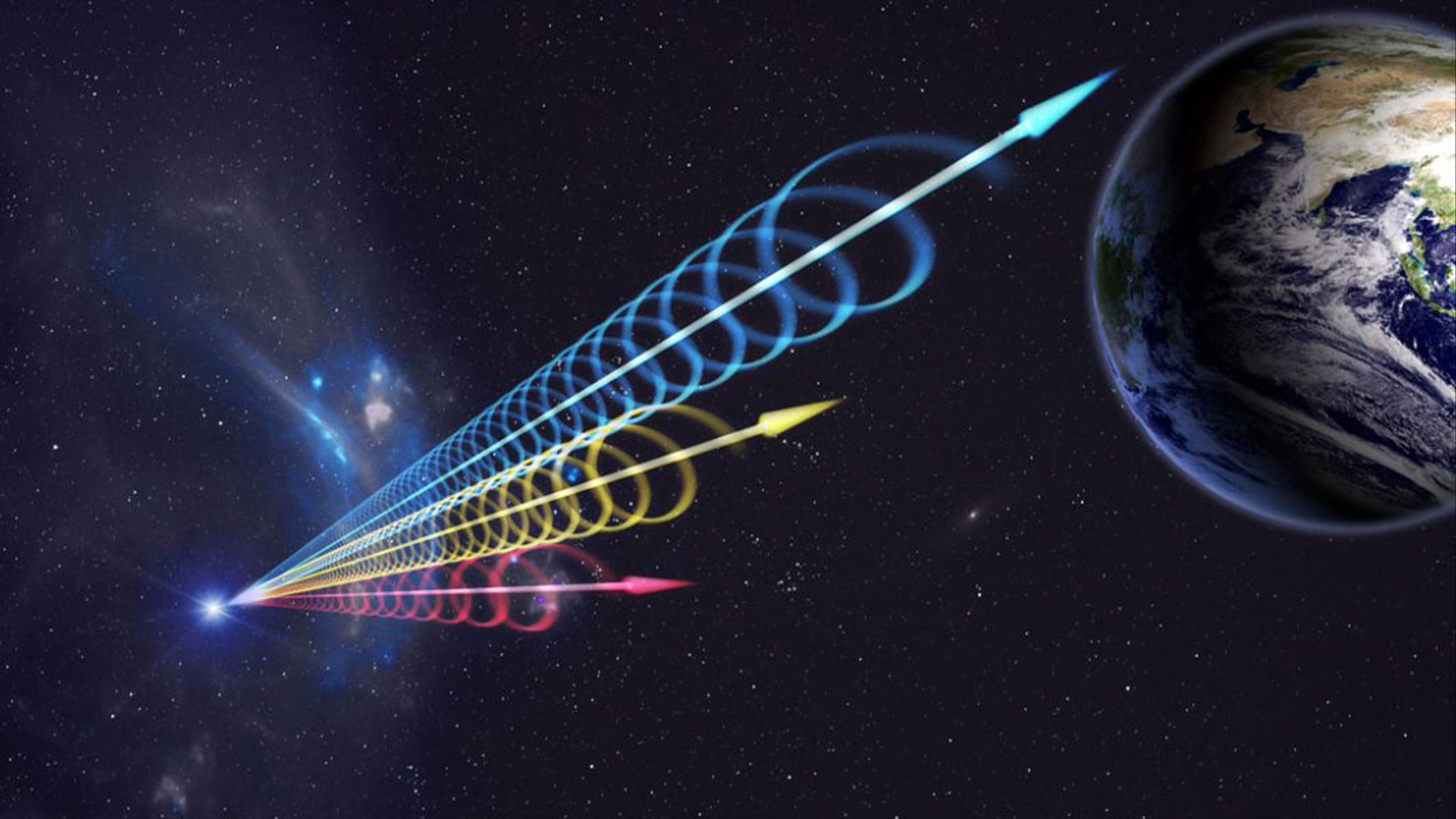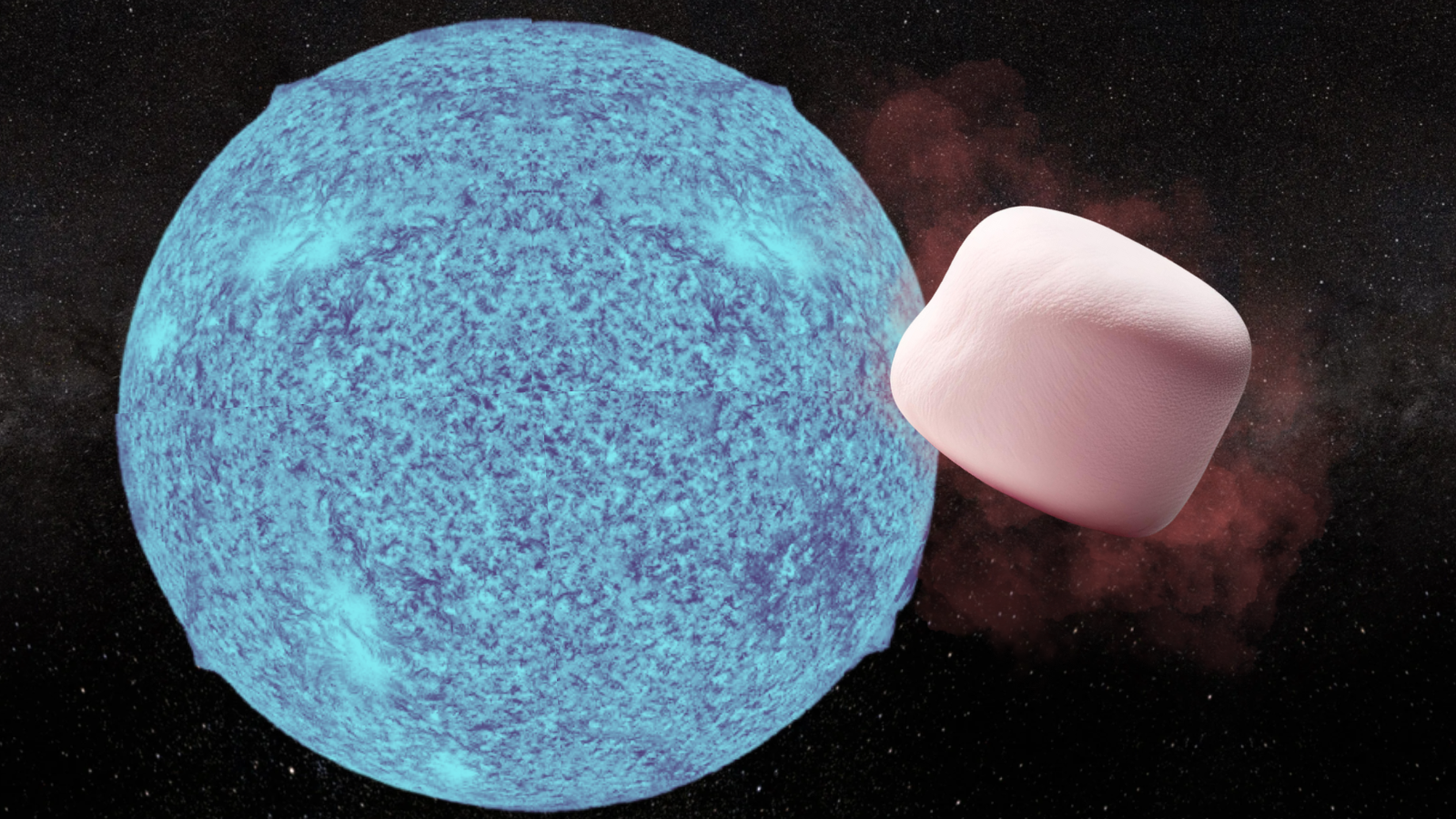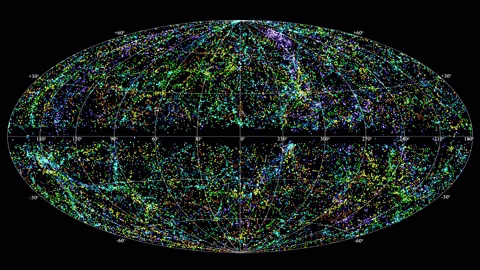Mysterious fast radio bursts could be caused by asteroids slamming into dead stars
An asteroid hitting a neutron star could release enough energy to power humanity for 100 million years, more than enough to explain fast radio bursts.

Scientists have discovered that mysterious blasts of energy called fast radio bursts (FRBs) may be created when asteroids slam into ultradense extreme dead stars called neutron stars. Such a collision releases enough energy to supply humanity's power needs for 100 million years!
FRBs are transient pulses of radio waves that can last from a fraction of a millisecond to a few seconds. In this period, an FRB can release the same amount of energy that it would take the sun several days to radiate.
The first FRB was observed in 2007, and since then, these blasts of energy have maintained their aura of mystery because they were infrequently detected until 2017. That was the year when the Canadian Hydrogen Intensity Mapping Experiment (CHIME) came online and began making frequent FRB discoveries.
"FRBs so far defy explanation, with over 50 potential hypotheses of where they come from - we counted!" team leader and University of Toronto scientist Dang Pham told Space.com.
The possible connection between FRBs and asteroids, as well as comets slamming into neutron stars, has been suggested before. This new research by Pham and colleagues further solidifies that link.
"It's been known for many years that asteroids and comets impacting neutron stars can cause FRB-like signals, but until now, it was unclear if this happened often enough across the universe to explain the rate at which we observe FRBs occurring," Pham said. "We have shown that interstellar objects (ISOs), an understudied class of asteroids and comets thought to be present between stars in galaxies throughout the universe, could be numerous enough that their impacts with neutron stars could explain FRBs!"
Pham added that the team's research also showed other expected properties of these impacts match up with observations of FRBs such as their durations, energies, and the rate at which they occur over the lifetime of the universe.
The question is: Even though asteroid impacts can be devastating (just ask the dinosaurs), how could they possibly release the same amount of energy that a star takes days to radiate?
Extreme stars mean extreme explosions
Neutron stars are created when massive stars die and their cores collapse, creating dense bodies with the mass of the sun, only crammed into a width no larger than the average city on Earth.
The result is a stellar remnant with extreme properties, such as the densest matter in the known universe (one teaspoon would weigh 10 million tons if brought to Earth) and magnetic fields that are the strongest in the universe, trillions of times more powerful than Earth's magnetosphere.
"Neutron stars are extreme places, with over the mass of the sun squeezed into a sphere about 12 miles (20 km) across, giving them some of the strongest gravitational and magnetic fields in the universe," team member and Oxford University astrophysicist Matthew Hopkins told Space.com. "This means that a huge amount of potential energy is released when an asteroid or comet drops onto one, in the form of a flash of radio waves bright enough to be seen across the universe."
So, how much energy are we talking about here? To consider this, let's swap out an asteroid for something a touch sweeter.
Sign up for the Live Science daily newsletter now
Get the world’s most fascinating discoveries delivered straight to your inbox.

According to NASA's Goddard Flight Center, if a normal-sized marshmallow were dropped to the surface of a neutron star, the gravitational influence of the dead star is so great that the treat would accelerate to speeds of millions of miles per hour. That means when the marshmallow hits the neutron star, the collision releases the energy equivalent to the simultaneous explosion of a thousand hydrogen bombs!
Exactly how much energy the asteroid/neutron star smash-up releases depends on several factors.
"The energy released depends on the size of the asteroid and the strength of the magnetic field on the neutron star, both of which can vary by a lot, by several orders of magnitude," Hopkins added. "For an asteroid 0.62 miles (1 km) across and a neutron star with a surface magnetic field strength over one trillion times the Earth's magnetic field strength, we calculate the energy released to be about 10^29 Joules (that's 10 followed by 28 zeroes).
"This is a huge number, about one hundred million times all the energy used by all of humanity over a year!"
Clearly, asteroids slamming into neutron stars can release enough energy to explain FRBs, but are these collisions frequent enough to account for FRB observations?
Could asteroid 'combo attack' neutron stars to create repeat FRBs?
Astronomers have detected FRBs from all over the sky, with some scientists estimating that 10,000 FRBs could occur at random points in the sky over Earth each day. If this team is right, that's a lot of collisions between neutron stars and asteroids.
Interstellar rocks are certainly abundant enough in the Milky Way to account for this rate; there are about 10^27 (10 followed by 26 zeroes) in our galaxy alone. But how often do these encounter a neutron star?
"The collision between one neutron star and an interstellar object is rare. We estimate it to be about one collision every 10 million years in the Milky Way," Pham said. "However, there are many neutron stars in the galaxy, and there are many galaxies! Taken together, we find that the neutron star-interstellar objects collision-rate in the universe is comparable with currently observed FRB rates."
Additionally, the researcher pointed out that the number of neutron stars and interstellar objects increases over the lifetime of the universe. That means the rate of neutron stars and interstellar object collisions should also increase over cosmic time.
"If this model is true, then we should observe FRB rates increase as the universe ages," Pham said. "This remains an open research question that could benefit from more observations!"

Even if this theory is correct, it doesn't answer everything about FRBs. That is mainly because there are two types of these energetic blasts of radiowaves.
Thus far, we have been talking about single-occurrence FRBs. However, there are also repeating FRBs that fire off more than once. Could asteroid incursions also explain repeat FRBs?
"We find that this model cannot account for repeating FRBs because a neutron star colliding with an interstellar rock is a rare, random event," Hopkins explained. "It is rare for an individual neutron star to collide with an interstellar object. In comparison, repeating FRBs generally occur at a much faster rate, with some observed to be as fast as two bursts per hour!"
Prior research has suggested that if a single-occurrence FRB is caused by collisions between a neutron star and an asteroid, then repeating FRBs could represent these dead stars colliding with an asteroid belt, like the one in our solar system between Mars and Jupiter.
"There are still some debates around this idea, specifically on how dense these debris fields must be. This scenario is beyond what we considered in our model, which is neutron stars colliding with interstellar objects," Pham said. "Further observations are needed to understand the emission mechanisms of FRBs and their sources."
Pham and Hopkins pointed out that the neutron star-interstellar object collision rates will depend on the kinds of galaxies, such as elliptical or spiral galaxies, in which they occur. That means astronomers will need to observe more FRBs and track them back to host galaxies to determine what type of galaxies are most associated with these blasts of energy.
"Understanding the evolution of FRB rates over cosmic time can also help us understand more about this model," Pham added. "More FRB observations could also place more constraints on how energetic these events are, which will inform us about how FRBs are emitted." The research team told Space.com this will be done with FRB observational projects, such as CHIME, the Canadian Hydrogen Observatory and Radio-transient Detector (CHORD), and the Australian Square Kilometre Array Pathfinder (ASKAP).
"Additional works to constrain how populated galaxies are with interstellar objects will also give us better information on how often neutron stars can collide with these objects in the universe," Pham concluded.
The team's results have been accepted for publication in the Astrophysical Journal. A preprint version of the team's paper is available on the repository site arXiv.
Originally posted on Space.com.
Robert Lea is a science journalist in the U.K. who specializes in science, space, physics, astronomy, astrophysics, cosmology, quantum mechanics and technology. Rob's articles have been published in Physics World, New Scientist, Astronomy Magazine, All About Space and ZME Science. He also writes about science communication for Elsevier and the European Journal of Physics. Rob holds a bachelor of science degree in physics and astronomy from the U.K.’s Open University











